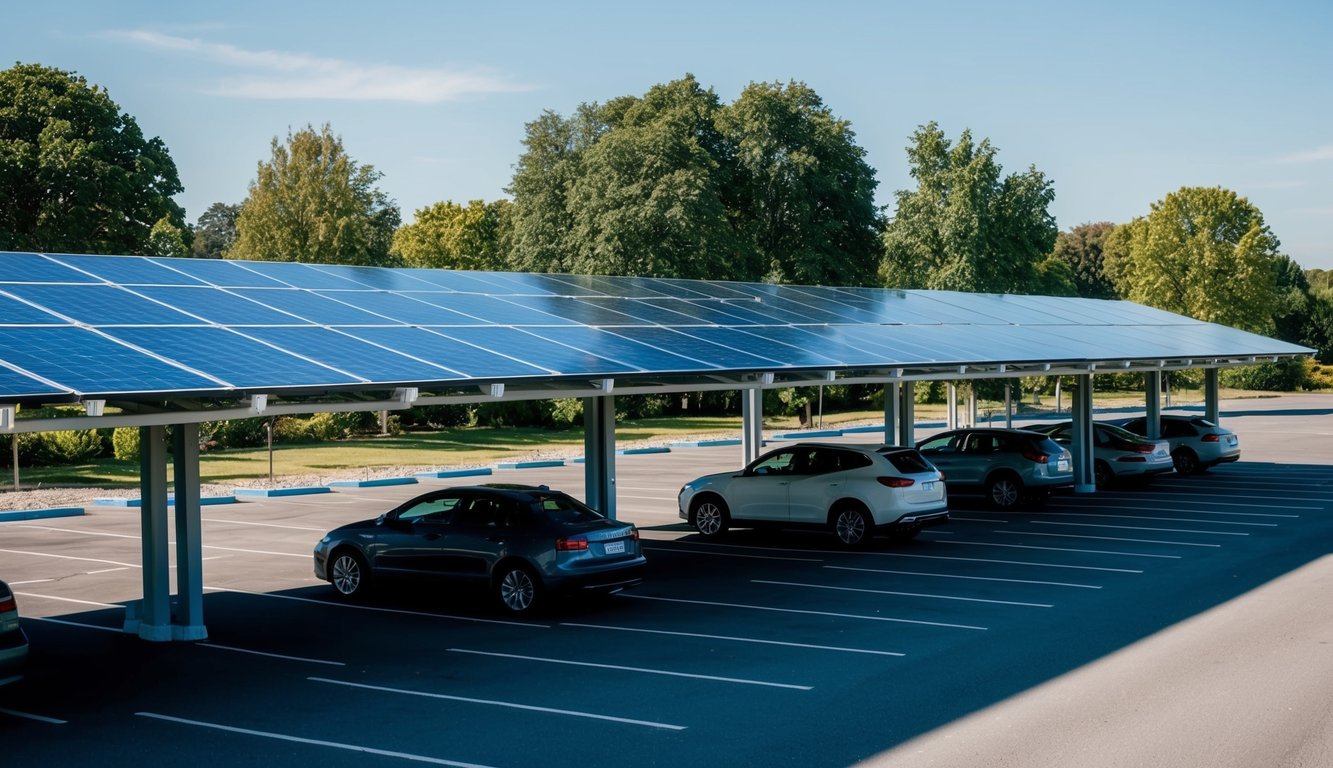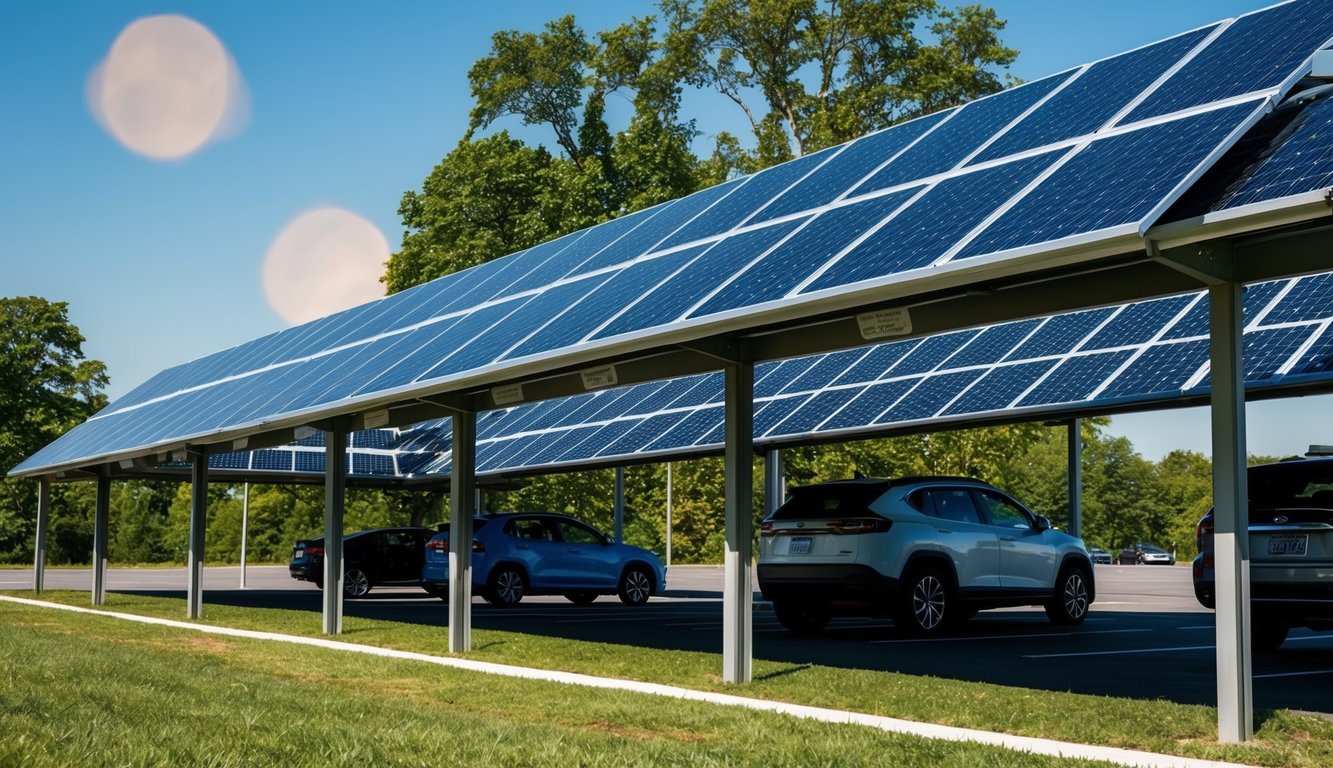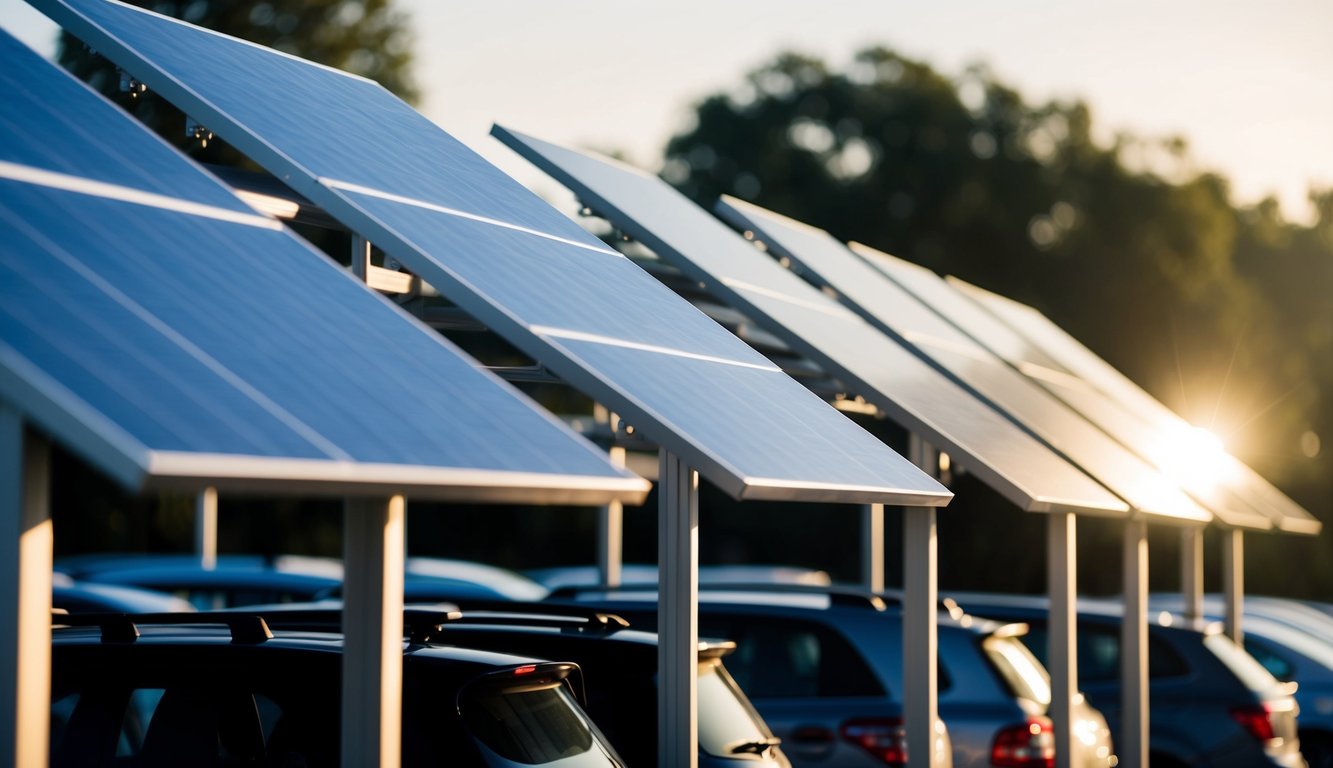Solar Carports: Innovative Power Solutions for Parking Areas
Solar carports provide a clever way to generate clean energy while protecting your vehicle. These structures combine covered parking with solar panels on the roof. You can power your car or home using renewable energy from a solar carport.
These systems work even on cloudy days, capturing daylight to produce electricity. Solar carports come in different sizes, from single-car designs to large commercial installations for car parks. You can choose from various styles, solar technologies, and optional features like electric vehicle chargers or battery storage.
Solar carports offer many benefits beyond just energy generation. They shield vehicles from harsh weather, add visual appeal to parking areas, and demonstrate a commitment to sustainability. For businesses, solar carports can attract eco-conscious customers while reducing energy costs. As solar technology improves, these dual-purpose structures are becoming more popular across the UK.
What Are Solar Carports?
Solar carports are structures that provide shelter for vehicles while generating clean electricity from sunlight. These innovative designs combine parking protection with renewable energy production.
Definition and Basic Concepts
Solar carports are covered parking structures with solar panels installed on their roofs. They serve two main purposes:
- Shielding vehicles from weather
- Producing solar electricity
These carports use photovoltaic (PV) panels to convert sunlight into usable power. The energy can be used on-site or fed back into the electrical grid.
Solar carports come in various sizes, from single-vehicle shelters to large multi-car systems. They can be freestanding or attached to buildings.
How Solar Carports Differ from Traditional Carports
Solar carports have several key differences from standard carports:
- Energy production: Solar carports generate electricity, while traditional ones do not.
- Roof design: PV panels form the roof of solar carports, replacing typical roofing materials.
- Orientation: Solar carports are positioned to maximise sun exposure for optimal power generation.
- Cost: Initial expenses are higher for solar carports due to PV technology.
- Long-term value: Solar versions can offset electricity costs over time.
Key Components and Design Elements
Solar carports consist of several essential parts:
- Supporting structure
- Solar panels
- Inverters
- Electrical wiring
- Optional battery storage
The design focuses on durability and efficiency. Sturdy frames, often made of galvanised steel, support the weight of the panels. The roof angle is carefully chosen to capture the most sunlight throughout the year.
Waterproofing is crucial to protect both vehicles and electrical components. Some designs include features like LED lighting or electric vehicle charging stations.
Benefits of Solar Carports
Solar carports offer numerous advantages for property owners and the environment. They provide clean energy generation while protecting vehicles and making efficient use of space.
Environmental Impact and Sustainability
Solar carports contribute significantly to reducing carbon footprints. These structures generate clean, renewable energy from sunlight, decreasing reliance on fossil fuels. By producing electricity on-site, they cut down on transmission losses associated with traditional power grids.
Solar carports help combat climate change by lowering greenhouse gas emissions. A typical solar carport can offset several tonnes of CO2 annually, equivalent to planting hundreds of trees.
These installations also raise awareness about renewable energy. They serve as visible symbols of a commitment to sustainability, potentially inspiring others to adopt eco-friendly practices.
Energy Cost Savings
Solar carports can lead to substantial savings on electricity bills. By generating your own power, you reduce the amount of energy you need to buy from the grid. This can result in significant cost reductions over time.
Many areas offer net metering programmes, allowing you to sell excess energy back to the grid. This further offsets your electricity costs and can sometimes lead to negative energy bills.
The initial investment in solar carports is often recouped within a few years through energy savings. After this payback period, the electricity generated is essentially free for the remaining lifespan of the system.
Vehicle Protection and Shade
Solar carports provide excellent protection for vehicles from harsh weather conditions. They shield cars from direct sunlight, rain, snow, and hail, helping to preserve paintwork and prevent interior damage.
The shade provided by solar carports keeps vehicles cooler in hot weather. This can improve comfort when entering the car and reduce the need for air conditioning, saving fuel.
For electric vehicle owners, solar carports offer an ideal charging solution. You can charge your car using clean, self-generated electricity, further reducing your carbon footprint.
Space Optimisation Benefits
Solar carports make efficient use of existing space. They turn parking areas into dual-purpose zones that provide both vehicle storage and energy generation. This is particularly valuable in urban areas where space is at a premium.
For businesses, solar carports can enhance property value and attract environmentally conscious customers. They demonstrate a commitment to sustainability that can improve brand image.
These structures can also integrate other features like LED lighting or electric vehicle charging stations. This multi-functionality further maximises the utility of the space.

Types of Solar Carport Installations
Solar carports come in various configurations to suit different needs and spaces. These structures provide covered parking while generating clean energy from sunlight.
Single-Row Carport Systems
Single-row carports are a popular choice for smaller areas. They typically cover one row of vehicles parked side-by-side. These systems are ideal for residential driveways or small business car parks.
Key features include:
- Simple design with a single sloped roof
- Easy to install and maintain
- Can accommodate 2-6 vehicles depending on length
- Suitable for narrow spaces or properties with limited land
Single-row carports often use ground-mounted panels. This setup allows for optimal panel angle and easy access for cleaning and repairs.
Multi-Row Carport Systems
Multi-row carports are larger structures designed for bigger car parks. They can cover several rows of vehicles, making them ideal for commercial properties or large residential complexes.
Benefits of multi-row systems:
- Maximise space utilisation
- Higher energy output due to more panels
- Can include built-in drainage systems
- Often feature EV charging stations
These carports may use a cantilevered design to reduce support posts and improve vehicle access. Some multi-row systems have flat roofs to simplify installation and maintenance.
Custom Design Options
Custom solar carports cater to unique site requirements or aesthetic preferences. These bespoke solutions can blend with existing architecture or create a standout feature.
Common customisation options:
- Curved or wave-shaped roofs
- Integrated lighting systems
- Specialised paint colours or finishes
- Adjustable panel angles for seasonal optimisation
Custom designs may incorporate additional features like rainwater harvesting or energy storage systems. These add-ons can boost sustainability and energy independence.
Commercial vs Residential Applications
Commercial solar carports are typically larger and more complex than residential ones. They often cover vast car parks at shopping centres, airports, or office complexes.
Commercial carport features:
- High-capacity inverters for grid connection
- Robust structural design to meet building codes
- Advanced monitoring systems for performance tracking
- May include billboard space for advertising
Residential carports are usually smaller and simpler. They focus on covering personal vehicles while generating power for home use.
Residential carport advantages:
- Lower upfront costs due to smaller size
- Can often be installed without planning permission
- May increase property value
- Provide shade and weather protection for vehicles
Both types can significantly reduce electricity bills and carbon footprints. The choice between commercial and residential depends on space, budget, and energy needs.

Cost and Investment Considerations
Solar carports require careful financial planning. The upfront costs can be significant, but long-term savings and incentives may offset the initial investment.
Initial Installation Expenses
Solar carport installation costs vary based on size and capacity. A small residential carport might cost £5,000 to £14,000, while larger commercial projects can reach six or seven figures. Factors affecting price include:
- Solar panel quality and efficiency
- Carport structure materials
- Labour and installation fees
- Permits and inspections
Custom designs or special features like electric vehicle charging stations can increase costs. It’s wise to get quotes from several installers to compare prices and options.
Long-term Financial Benefits
Solar carports can lead to significant savings over time. Key benefits include:
- Reduced electricity bills
- Protection for vehicles from weather damage
- Potential increase in property value
By generating your own electricity, you’ll rely less on the grid. This can shield you from rising energy prices. Some owners even sell excess power back to the grid, creating a new income stream.
The dual-purpose nature of solar carports—providing both parking and power—makes them an efficient use of space.
Available Tax Incentives and Rebates
The UK government offers several schemes to encourage solar adoption:
- Smart Export Guarantee (SEG): Pays you for excess electricity you feed into the grid
- Reduced VAT on solar equipment: 5% instead of the standard 20%
- Capital Allowances: Businesses can claim tax relief on solar investments
Local councils may offer additional grants or incentives. Check with your area’s energy office for up-to-date information on available programmes.
Return on Investment Analysis
To calculate your return on investment (ROI), consider:
- Total installation costs
- Estimated annual energy savings
- Potential income from selling excess power
- Available tax incentives and rebates
Most solar carports pay for themselves within 5-10 years. After this point, they continue to generate savings for their 25-30 year lifespan.
Factors affecting ROI include:
- Local sunshine levels
- Electricity rates in your area
- System efficiency and maintenance costs
A professional solar installer can provide a detailed ROI analysis based on your specific situation. This will help you make an informed decision about whether a solar carport is right for you.

Planning and Implementation
Solar carport projects require careful planning and execution. Proper site assessment, adherence to regulations, and thoughtful installation are key to success. Regular maintenance ensures optimal performance.
Site Assessment Requirements
A thorough site assessment is crucial for solar carport projects. You need to evaluate the available space, sunlight exposure, and structural integrity of existing buildings or structures.
Key factors to consider:
- Solar radiation levels
- Shading from nearby objects
- Ground conditions
- Electrical infrastructure
- Vehicle traffic patterns
Use professional tools like solar pathfinders and 3D modelling software for accurate assessments. These help determine the best placement and orientation of solar panels for maximum energy production.
Permitting and Regulations
Understanding local rules is vital for solar carport installations. Recent changes have simplified the process in many areas.
Key points:
- Check local planning requirements
- Obtain necessary permits before starting work
- Comply with building codes and safety standards
- Consider heritage site restrictions if applicable
Some areas may require additional approvals for large-scale projects. Work with local authorities to ensure your solar carport meets all legal requirements.
Installation Process Overview
The installation of solar carports involves several steps:
- Site preparation
- Foundation construction
- Carport structure assembly
- Solar panel mounting
- Electrical wiring and connections
- Inverter and monitoring system setup
Skilled professionals should handle each stage. Proper safety measures are essential throughout the process. Weather conditions can affect the installation timeline, so plan accordingly.
Maintenance Considerations
Regular upkeep keeps your solar carport running smoothly. Create a maintenance plan that includes:
- Panel cleaning: Remove dirt and debris quarterly
- Electrical checks: Inspect wiring and connections yearly
- Structural inspections: Check for damage or wear annually
- Performance monitoring: Track energy output monthly
Consider professional maintenance services for complex issues. Prompt repairs can prevent small problems from becoming costly. Keep detailed records of all maintenance activities for warranty purposes and future reference.
Solar Carport Technologies
Solar carports use advanced technologies to generate renewable energy while providing shelter for vehicles. These structures combine innovative panel designs, mounting systems, and smart features to create efficient and sustainable energy solutions.
Panel Types and Efficiency
Solar carports use different types of photovoltaic panels to convert sunlight into electricity. Monocrystalline panels offer high efficiency and sleek looks. Polycrystalline panels provide a good balance of cost and performance. Thin-film panels are lightweight and flexible, ideal for curved roofs.
Some carports use transparent solar glass, which allows light to pass through while generating power. This creates a bright, open feel beneath the structure. Panel efficiencies range from 15-22% for standard options, with premium panels reaching up to 25% efficiency.
Bifacial panels can boost output by capturing reflected light on both sides. This is useful for carports in snowy areas or with light-coloured surfaces underneath.
Mounting Systems
Carport mounting systems must be sturdy enough to support heavy panels and withstand wind and snow loads. Common designs include:
- Y-frame: Provides excellent stability and a sloped roof for water drainage
- T-frame: Offers a clean look with central support columns
- Cantilever: Creates an open feel with supports on only one side
Adjustable racking allows panel angles to be optimised for maximum sun exposure. Some systems include tracking mounts that follow the sun’s path throughout the day, increasing energy yield by up to 25%.
Energy Storage Options
Many solar carports include battery storage to make the most of generated power. This allows excess daytime energy to be used at night or during cloudy periods. Common battery types include:
- Lithium-ion: High energy density and long lifespan
- Lead-acid: Lower cost but shorter lifespan
- Flow batteries: Good for large-scale storage
Some carports use electric vehicle batteries for storage, creating a symbiotic relationship between car charging and energy management. This vehicle-to-grid (V2G) approach can help balance loads on the electrical grid.
Smart Integration Features
Modern solar carports often include smart technologies to optimise performance and user experience. These may include:
- Monitoring systems to track energy production and consumption
- Automated shading that adjusts based on sun position and temperature
- LED lighting powered by the solar array
- EV charging stations with smart scheduling
- Grid connection for selling excess power back to utilities
Some carports use artificial intelligence to predict energy needs and adjust storage and consumption patterns. This can help maximise self-consumption and reduce reliance on grid power.
Conclusion
Solar carports offer a practical solution for clean energy generation. You can harness the sun’s power while protecting your vehicles. These structures blend functionality with sustainability.
Solar carports provide several key benefits:
- Generate renewable electricity
- Shelter cars from weather
- Reduce carbon emissions
- Lower energy bills over time
Installing a solar carport requires planning and investment. However, the long-term savings and environmental impact make it worthwhile for many property owners.
As solar technology improves, carports become more efficient and affordable. You may see these structures appearing more frequently at homes, businesses and car parks.
Before adding a solar carport, consider:
- Available space
- Local regulations
- Energy needs
- Budget constraints
With proper design and installation, a solar carport can serve you well for decades. It transforms an ordinary parking area into a clean energy asset.
Solar carports represent a step towards a greener future. They allow you to generate power from an otherwise unused space. As renewable energy grows, these innovative structures will likely play an increasing role.

